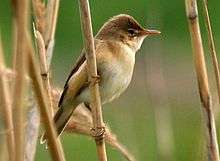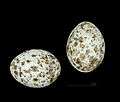Eurasian reed warbler
| Eurasian reed warbler | |
|---|---|
 | |
| Scientific classification | |
| Kingdom: | Animalia |
| Phylum: | Chordata |
| Class: | Aves |
| Order: | Passeriformes |
| Family: | Acrocephalidae |
| Genus: | Acrocephalus |
| Species: | A. scirpaceus |
| Binomial name | |
| Acrocephalus scirpaceus (Hermann, 1804) | |
The Eurasian reed warbler, or just reed warbler (Acrocephalus scirpaceus) is an Old World warbler in the genus Acrocephalus. It breeds across Europe into temperate western Asia. It is migratory, wintering in sub-Saharan Africa. The genus name Acrocephalus is from Ancient Greek akros, "highest", and kephale, "head". It is possible that Naumann and Naumann thought akros meant "sharp-pointed". The specific scirpaceus is from Latin and means "reed".[2]
This small passerine bird is a species found almost exclusively in reed beds, usually with some bushes. The 3–5 eggs are laid in a basket nest in reeds. The chicks fledge after 10 or 11 days. This species is usually monogamous.[3]
The Eurasian reed warbler looks similar to the great reed warbler, but the great reed warbler is larger in size and has a stronger supercilium.
The Eurasian reed warbler is one of the species that are brood parasitised by the common cuckoo.
This is a medium-sized warbler, 12.5–14 cm in length. The adult has an unstreaked brown back and buff underparts. The forehead is flattened, and the bill is strong and pointed. The sexes are identical, as with most warblers, but young birds are richer buff below. Like most warblers, it is insectivorous, but will take other small food items, including berries.
The song is a slow, chattering jit-jit-jit with typically acrocephaline whistles and mimicry added.
 Common cuckoo chick in a reed warbler nest.
Common cuckoo chick in a reed warbler nest. Reed warbler eggs
Reed warbler eggs
References
- ↑ BirdLife International (2014). "Acrocephalus scirpaceus". IUCN Red List of Threatened Species. Version 2014.2. International Union for Conservation of Nature. Retrieved 28 August 2014.
- ↑ Jobling, James A (2010). The Helm Dictionary of Scientific Bird Names. London: Christopher Helm. pp. 30, 350. ISBN 978-1-4081-2501-4.
- ↑ Leisler, B. & Wink, Michael (2000): Frequencies of multiple paternity in three Acrocephalus species (Aves: Sylviidae) with different mating systems (A. palustris, A. arundinaceus, A. paludicola). Ethology, Ecology & Evolution 12: 237–249. PDF fulltext
External links
| Wikimedia Commons has media related to Acrocephalus scirpaceus. |
- Eurasian reed warbler videos, photos & sounds on the Internet Bird Collection
- Avibase
- Ageing and sexing (PDF; 2.3 MB) by Javier Blasco-Zumeta & Gerd-Michael Heinze
Bibliography
- Kishkinev, D., Chernetsov, N., Pakhomov, A., Heyers, D., and Mouritsen, H. (2015). Eurasian reed warblers compensate for virtual magnetic displacement. Curr. Biol. 25, R822–R824
